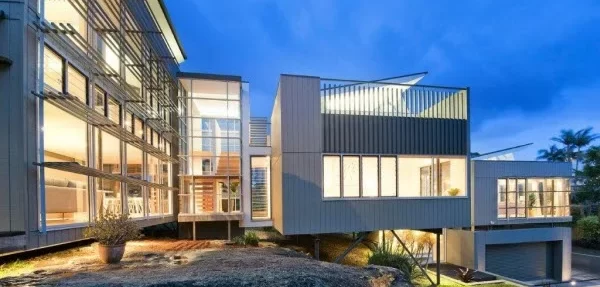Freshwater
Concept: Creating a light, airy, character-filled three-level Hampton-style beach home on a small corner site

The doors disappear and the windows reveal a view too spectacular to be hidden behind a series of window frames… it is the quintessential Australian lifestyle that calls for smart design with a focus on the seamless integration of the indoors and outdoors.
More than adding extra windows or a few glass doors, good design seamlessly integrates the home into the space in which it sits, simultaneously inviting the surrounds into the home and calling the residents to look up and enjoy nature at its best.
John Hooghuis, Playoust Churcher Design Director, is aware of the benefits that this style of design can bring to homeowners.

“Blurring the lines between the indoors and the outdoors gives a house a great deal more functionality. By making the windows and doors flexible, you can combine indoor and outdoor living spaces, giving flexibility in changing conditions and often reducing the cost and area of a home. By inviting the outdoors into the home, you create an intimacy with your surrounds.
Often it’s about protecting and focusing on the views available, and removing distracting clutter. As many Sydney homes are on steep sites, the views are often downwards, so bringing the living spaces to the edge of the building and locating outdoor areas to the side will protect the downward views from the interior of your home.”
As Northern Beaches and North Shore Architects, we are experienced at delivering seamless indoor/outdoor design… and our work speaks for itself. Like the Castlecrag house where John worked his magic to create doors that seemingly disappear.

The Castlecrag house was an old “Sydney School” house, so familiar to many with its exposed clinker bricks and timber beams.
The original narrow verandahs along the view side of the home were virtually unusable due to their small size – the balusters blocking the water views – while the living and dining spaces were much smaller than the owners would have liked. Extending was not an option due to constraints on the footprint of the home.
Inspired by elements of iconic Sydney architect Ken Woolley’s Palm Beach House, which John had studied while at Uni, the verandahs were removed and the floor space was extended to the very edge of the building.
The new walls featured large sliding doors that disappeared on tracks beyond the edge of the building, leaving a clean opening with an almost invisible glass baluster as the unobtrusive dividing line between indoors and outdoors. The view became the hero of the room.

These flexible indoor/outdoor living spaces were complemented by an external terrace attached to the kitchen, intimately connecting the space to the lush garden and rock surrounds… and, again, to the beautiful view on one side.
“In my mind there’s something special about seeing the doors themselves disappear behind walls so you just have an opening to the outside.
A view can be far more elegant if it is framed by a clean and uncluttered opening. What we try to do is slide the doors away altogether to create a much cleaner and simpler entrance to the outside – you just see the opening and not the doors, leaving people wondering if it is an internal room or a verandah.” – John Hooghuis, Playoust Churcher Design Director

While most often associated with modern architecture, the principles of seamless indoor/outdoor design can work equally well in traditionally styled homes with standard window and door systems.
This was the case with the St Ives Estate renovation.

Throughout the renovation process we maintained the thinness of the original house plan to take advantage of the stunning outlooks on both sides of the home.
As you walk through the hallway that runs through the rooms in the home you can alternately enjoy the view over the pool to the south and the front gardens to the north.
The pavilions added to the home were designed in such a way that they sit detached from the home, using windows and glazed connections to connect them to the main building, providing glances out into the gardens when passing through from space to space.

The breakfast room was a small pavilion added to the home, looking out over the pool and to the bushland beyond.
Two of the three exterior walls were fitted with bifold doors opening to the terraces… so as to not limit the view of the third wall we created a full glass picture window, to feature the full and complete view.
Using bifold doors that disappear out of view against the external walls of the house creates the impression of a completely open room – a nice trick for a flexible indoor/outdoor spaces.

With some homes, like the home we designed in May Road, Dee Why, the seamless integration of the indoors and outdoors is about the experience of inviting the outside, inside.
The home was designed as a series of pavilions linked by glazed connections with bridges and stairs.

The sloping site called for an innovative design that could navigate the slope, creating an interesting journey from the entry up to the living areas, with the glazed connections bringing the landscape close in to the home on the way.
As you walk through the bridge areas in the home you are directly connected to the landscape which comes in between the pavilions, ultimately bringing the garden into the centre of the home as an experience.
On the eastern end of the home, the living room opens up to a large deck floating over rock platforms, with another garden terrace on the western end off the dining area, again giving a flexible living space that can be opened up to the garden areas.
If you want to create a seamless indoor/outdoor living design, we will take the time to listen to your vision and help you to bring it to life.
Our team of architects are talented and passionate about what they do. For us it all comes back to good design and partnering with our clients to create amazing dream homes.
Contact us to discuss your dream home vision for seamless indoor/outdoor living with our team.
It’s about more than glass doors—it’s the art of integrating a home within its environment so naturally that doors fade from view, framing nature as the core element of your living space.
In a Castlecrag project, verandahs were removed and sliding glass doors were engineered to retract fully beyond the building’s edge—creating a seamless transition to the outdoor terrace and making the view the true focal point.
Absolutely. In a St Ives renovation, new pavilions were constructed with detached glazing and bifold doors—maintaining classic aesthetics while delivering panoramic views and seamless garden connection.
A home in Dee Why uses multiple pavilions connected by glass bridges and stairs—bringing the landscape deep into the interior. Decks and garden terraces extend living zones right into the natural setting.

Playoust Churcher champions the concept of emotional functionalism: creating homes that are not only practical but also inspire—designs that foster calm and a deep connection to Northern Beaches living.

Architects navigate the challenges of steep terrain—minimizing physical strain (like carrying groceries across levels)—through intelligent layout planning, integrated garages, and landscape-responsive designs that optimize light, views, and flow.

Modern beach homes blur the boundaries between inside and out—using features like disappearing doors, expansive glazing, and integrated courtyards—so the home feels immersed in its natural setting.

Designs account for the beach lifestyle—such as discreet storage, outdoor showers, and creative drying solutions—and respect “view-sharing” principles to preserve neighbourhood outlooks, aiding both design quality and DA approval
Managing Director & Nominated Architect
NSW Architect Registration No. 5924
With over 30 years of architectural experience, Brett Churcher leads Playoust Churcher Architects with a rare combination of design expertise and commercial insight. As a registered architect and Managing Director, Brett has played a pivotal role in delivering high-end single residential homes and boutique medium-density developments across Sydney’s North Shore and beyond.
Brett’s unique strength lies in his deep understanding of both architectural design and the Sydney property market. His valuation background enables him to align creative vision with practical feasibility, ensuring each project achieves both aesthetic excellence and financial viability.
At Playoust Churcher, Brett drives the studio’s growth, strategy, and leadership, while remaining closely connected to what matters most: the client. His ability to see the bigger picture from a client’s perspective and to guide projects seamlessly through the design process is at the heart of his role and reputation.

Reach out to Brett to explore how Playoust Churcher can bring it to life—with clarity, creativity and confidence.
Concept: Creating a light, airy, character-filled three-level Hampton-style beach home on a small corner site
Concept: Adapting a beautiful family heritage home in a quiet street on a large site to suit the family’s lifestyle
Concept: Designing a new family home that maximises the views and introduces a sense of open space
Concept: A complex yet successful renovation of this stunning heritage home in a conservation area
Concept: A 1970s build transformed into a bright, open design maximising stunning harbour views
Concept: A complete rebuild of half the property over two levels, whilst also incorporating the property next door
Concept: A majestic holiday home that pushes the design envelop, blending sustainable materials and natural light
Concept: A major ground floor renovation of a large estate with a new three-car garage and 14 metre pool
© Copyright Playoust Churcher 2025 All rights reserved. Website by Brilliant Digital.
We live and work on the lands of the Gadigal people of the Eora nation. We acknowledge their traditional custodianship of the land and pay respects to their Elders past, present and emerging.